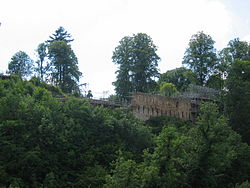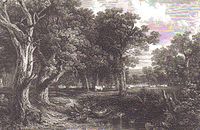Cadzow Castle: Difference between revisions
Created page with "{{Infobox castle |name=Cadzow Castle |county=Lanarkshire |picture=CadzowCastle01.JPG |picture caption=Cadzow Castle across the Avon Gorge |os grid ref=NS734534 |latitude=55.76..." |
m clean up, typos fixed: As a result → As a result, |
||
| Line 18: | Line 18: | ||
The Castle's name is pronounced ''kadyo'': the ''z'' was originally the letter yogh, ȝ. | The Castle's name is pronounced ''kadyo'': the ''z'' was originally the letter yogh, ȝ. | ||
The town of Hamilton was formerly known, like the castle, as Cadzow or Cadyou<ref>George Chalmers, ''Caledonia, Or, A Historical and Topographical Account of North Britain from the Most Ancient to the Present Times: With a Dictionary of Places, Chorographical and Philological'', Vol. 6 (A. Gardner, 1890), p. 683.</ref> | The town of Hamilton was formerly known, like the castle, as Cadzow or Cadyou,<ref>George Chalmers, ''Caledonia, Or, A Historical and Topographical Account of North Britain from the Most Ancient to the Present Times: With a Dictionary of Places, Chorographical and Philological'', Vol. 6 (A. Gardner, 1890), p. 683.</ref> until renamed in 1455 in honour of James Hamilton, 1st Lord Hamilton. | ||
==History== | ==History== | ||
| Line 28: | Line 28: | ||
===The 16th-century castle=== | ===The 16th-century castle=== | ||
The present castle was built around 1530 by Sir James Hamilton of Finnart, who also constructed nearby [[Craignethan Castle]]. Following her escape from [[Loch Leven Castle]] in 1568, Mary, Queen of Scots, stayed here. As a result it was destroyed by forces of the Earl of Mar, regent for James VI, in the late 16th century, as retaliation against the Hamiltons for their support of Mary. It was partially rebuilt in the 18th century, to serve as a folly within the Duke's park. | The present castle was built around 1530 by Sir James Hamilton of Finnart, who also constructed nearby [[Craignethan Castle]]. Following her escape from [[Loch Leven Castle]] in 1568, Mary, Queen of Scots, stayed here. As a result, it was destroyed by forces of the Earl of Mar, regent for James VI, in the late 16th century, as retaliation against the Hamiltons for their support of Mary. It was partially rebuilt in the 18th century, to serve as a folly within the Duke's park. | ||
==The castle today== | ==The castle today== | ||
Revision as of 23:21, 30 January 2016
| Cadzow Castle | |
|
Lanarkshire | |
|---|---|
 Cadzow Castle across the Avon Gorge | |
| Location | |
| Grid reference: | NS734534 |
| Location: | 55°45’38"N, 4°1’3"W |
| History | |
| Information | |
| Condition: | Ruined, dangerous |
| Owned by: | Historic Scotland |
Cadzow Castle, now in ruins, was constructed between 1500 and 1550 on the site of an earlier royal castle, one mile south-east of the centre of Hamilton in Lanarkshire.
The castle sits above a gorge overlooking the Avon Water in what is now Chatelherault Country Park, but was previously the hunting and pleasure grounds of the Duke of Hamilton's estate of Hamilton Palace. The ruin is a category B listed building and a Scheduled Ancient Monument.[1][2]
Name
The Castle's name is pronounced kadyo: the z was originally the letter yogh, ȝ.
The town of Hamilton was formerly known, like the castle, as Cadzow or Cadyou,[3] until renamed in 1455 in honour of James Hamilton, 1st Lord Hamilton.
History
The early castle
The ancient kings of Strathclyde are said to have had a hunting lodge at Cadzow, before that kingdom was absorbed by Scotland in the 12th century. The original Cadzow Castle was built in the 12th century as an occasional royal residence for King David I (1124–1153). Royal charters of David's reign were issued from here as early as 1139. His successors Alexander II, Alexander III and others down to Robert the Bruce also used the castle, primarily as a hunting lodge. It is possible that this earlier castle was on an alternative site at NS729548, now known as Castlehill, although the area is now a housing estate.

The estate of Cadzow was divided in 1222, with Cadzow Castle passing to the Comyns. After the victory of Robert the Bruce, the Comyns, his longstanding rivals, lost their lands, and Bruce granted the castle to Walter FitzGilbert de Hambeldon in the early 14th century. FitzGilbert was ennobled as the first Baron of Cadzow, and is the ancestor of the Dukes of Hamilton. He constructed a motte near the town (NS729548), which remains, adjacent to the M74 motorway.
The 16th-century castle
The present castle was built around 1530 by Sir James Hamilton of Finnart, who also constructed nearby Craignethan Castle. Following her escape from Loch Leven Castle in 1568, Mary, Queen of Scots, stayed here. As a result, it was destroyed by forces of the Earl of Mar, regent for James VI, in the late 16th century, as retaliation against the Hamiltons for their support of Mary. It was partially rebuilt in the 18th century, to serve as a folly within the Duke's park.
The castle today
The site is now owned and managed by Historic Scotland. There is no public access to the ruins, as the structure is unstable, and largely supported by scaffolding. Footpaths within the country park allow visitors to view the ruin. The Duke's Bridge, built high across the Avon Gorge, offers the most dramatic view of the ruins above the wooded gorge. A series of excavations, sponsored by Historic Scotland, took place at the castle between 2000 and 2003.
Outside links
| ("Wikimedia Commons" has material about Cadzow Castle) |
References
- ↑ "Cadzow Castle, Listed Building Report". Historic Scotland. http://hsewsf.sedsh.gov.uk/hslive/hsstart?P_HBNUM=12483. Retrieved 2010-04-19.
- ↑ "Entry in the Schedule of Monuments, The Monument Known as Cadzow Castle". Historic Scotland. 2003. http://hsewsf.sedsh.gov.uk/eschedule/show?id=90342&OK=Y. Retrieved 2010-04-19.
- ↑ George Chalmers, Caledonia, Or, A Historical and Topographical Account of North Britain from the Most Ancient to the Present Times: With a Dictionary of Places, Chorographical and Philological, Vol. 6 (A. Gardner, 1890), p. 683.
